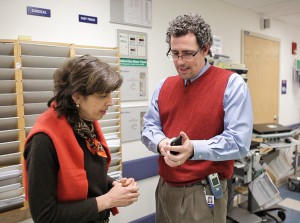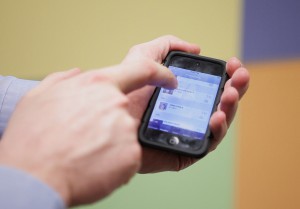
Debra Weiner speaks with Emergency Department Fellow Joel Hudgins who holds one of the iPhones piloting BEAPPER
For Debra Weiner, MD, PhD, working in the Emergency Medicine Department is a numbers game. During a 12-hour shift she works with more than 50 other providers, sees up to 25 patients and analyzes multiple lab results. Every day she’s also meeting new staff members in addition to new patients.
“People don’t know each other,” Weiner said at a recent Innovators’ Forum, a monthly internal lecture series intended to showcase and encourage new developments at Children’s Hospital Boston. “We have over 100 nurses and physicians and over 200 trainees that filter in [every two to four weeks]… it’s hard to remember who everyone is and what they do.”
Coupled with the frenetic pace of Children’s Emergency Department (ED), remembering names and managing the flow of patients becomes a constant challenge.

BEAPPER will provide real time updates about patients to doctors and nurses in the Emergency Department.
Weiner thought there was room for improvement. A better communication system would help clinicians meet each other before treating patients, and could even alert them in real time when lab results were back or when beds became available.
With a smartphone app in mind, she applied for a grant from Children’s Technology Development Fund.
With money from the fund and programming help provided through Children’s Innovation Acceleration Program, via its FastTrack Innovation in Technology Award, Weiner started prototyping.
A team of software developers took her concept and built an iPhone app that would allow physicians and nurses to communicate about incoming patients, lab results and a patient’s health status or wait time through brief messages similar to tweets.
“Inspired by Twitter and by Yammer, which is the business model that asks, ‘what is happening with our project,’ I wanted to create an analogous software for the medical setting,” Weiner said.
The app will display patient profiles, the patient’s chief complaint, how long he or she has been waiting, any allergies and which room that patient is assigned to. A single log-in allows the app to be used on the go, from any location within the hospital.
All patients’ information is kept confidential and the information is erased from the iPhones as soon as a physician logs out of the BEAPPER app.
Weiner named the software B.E.A.P.P.E.R.— the Bidirectional Electronic Alert Patient-Centered Provider Encounter Record—and it’s already garnering praise from the top ranks at Children’s. “What’s exciting about B.E.A.P.P.E.R. is that it’s lightweight and fast,” says Naomi Fried, PhD, chief innovation officer. “The ease of use and friendly graphic interface are big wins for this project.”
If physicians and nurses can save just five minutes per patient, Weiner calculates that the ED would be able to treat 1,389 more patients each year. And she hopes her system will eventually be used by every physician, nurse and trainee hospital-wide.
Several iPhones are now being tested in the ED and results will be available within the next few months.
“We are creating a standard of care that will dictate what the standard of care will be nationally,” Weiner said.






